Green Construction
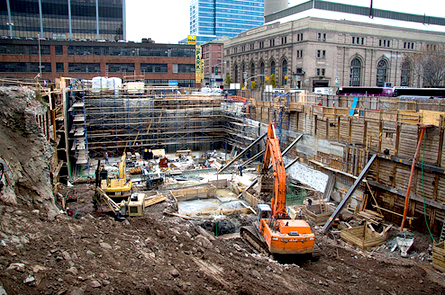
When Paul Stein pushed for thick windows and fancy air filters for his new office in lower Manhattan soon after 9/11, it was mainly because he was worried about lingering contaminants from the collapse of the Twin Towers.
But these measures have also wound up protecting him against a different kind of pollution -- pollution that Stein, who works on safety issues for his union, says his office at 90 Church Street is "surrounded by": pollution from construction. It is a problem that goes far beyond lower Manhattan.
From the proposed Atlantic Yards project in downtown Brooklyn to the water filtration plant in the northern Bronx, critics almost always complain not just about the project itself, but about the inconvenience, pollution, noise and dangerous accidents they will face during its construction.
The construction downtown is unique in that the contaminants from Ground Zero are still an issue. In late September, the Environmental Protection Agency finally approved a plan to demolish the Deutsche Bank Building adjacent to the site, after a long debate over how best to ensure that the asbestos and other dangerous chemicals in the building are not released into the air; the building will come down over the next year. Similar issues must be resolved for other buildings that are either known or suspected to be contaminated. The huge scale of the development downtown also ensures that there will be more pollution than in a project of conventional size.
But, in varying degrees, the same problems face construction sites throughout the city. And, increasingly, those involved are finding solutions in the movement being called green construction -- a nationwide effort to build in a way that is sensitive to the environment. Within the last several weeks both the City Council and Mayor Michael Bloomberg have been bringing more focus to policies that will encourage the city to build greener.
GREEN BUILDINGS, GREEN CONSTRUCTION
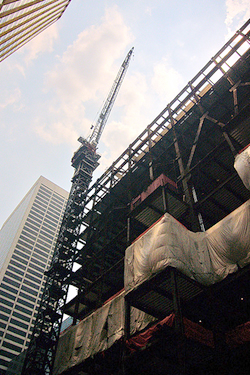 The enthusiasm for green buildings among developers, public officials, and environmental activists is palpable. While the word generically refers to buildings that are environmentally friendly, it has also become shorthand for a set of standards put out by the United States Green Building Council called the Leadership in Energy and Environmental Design, or LEED, system. LEED puts priority on using energy efficiency, employing innovative construction materials, and recycling.
The enthusiasm for green buildings among developers, public officials, and environmental activists is palpable. While the word generically refers to buildings that are environmentally friendly, it has also become shorthand for a set of standards put out by the United States Green Building Council called the Leadership in Energy and Environmental Design, or LEED, system. LEED puts priority on using energy efficiency, employing innovative construction materials, and recycling.
The plans to make Ground Zero a model of environmentally friendly construction are ambitious. All of the buildings on the site of the World Trade Center will meet a high level of LEED Standards, say Governor George Pataki and Larry Silverstein, the developer in charge of much of the construction there. Before these green buildings can exist, though, they must be built. And construction is a dirty process.
While green building standards are primarily focused on the final product, there is also increasing interest in making construction itself less harmful to the environment.
This can be seen in lower Manhattan, where between 5,000 and 10,000 trucks are expected to travel each month for the next four years or so, participating in $10 billion worth of construction projects in and around Ground Zero. Each project will cause noise, pollution, and traffic. But various efforts are being made to minimize these problems, mirroring what some describe as a fundamental change in the construction industry.
Less Truck Traffic
Environmental advocates are discussing strategies to reduce the overall amount of truck traffic coming to lower Manhattan.
One calls for better coordination between construction projects. Common areas could be established where trucks would drop off concrete and materials for more than one project, instead of having each project arrange its own deliveries. Another plan would establish a radio dispatcher to coordinate trucks coming downtown.
The Lower Manhattan Construction Command Center – a government agency formed by Mayor Michael Bloomberg and Governor George Pataki in November 2004 – would be in charge of this if it were to happen. The center says it is considering such plans, but a spokesma describes them as "just ideas" at this point. If such coordination works downtown it could serve as a model for other areas handling multiple development projects, says Tom Stabile, the editor of New York Construction News, a trade magazine.
But Michael Deane of Turner Construction says that such coordination will be difficult to replicate in other areas because it would require competitors to cooperate in unusual ways.
"It would have to be an altruistic thing," he said.
Buying Locally
A more likely way to reduce the environmental impact of trucks, Deane says, is for construction companies to make efforts to get their materials from nearby suppliers. While this doesn't necessarily reduce the impact on the area of construction itself, it can make the overall process much cleaner.
This is already happening for two major reasons. First, it makes economic sense, because carrying heavy materials long distances costs money. Second, the LEED rating system gives points to builders who use local materials.
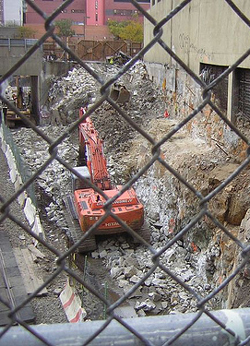 Action by the city government is turning LEED incentives into requirements. The city's new green building law, which will take effect on January 1, requires city-run construction projects worth more than $2 million to comply with the LEED standards (projects over $12 million are also required to meet energy efficiency standards). About $12 billion in construction is likely to be affected over the next ten years, according to the City Council.
Action by the city government is turning LEED incentives into requirements. The city's new green building law, which will take effect on January 1, requires city-run construction projects worth more than $2 million to comply with the LEED standards (projects over $12 million are also required to meet energy efficiency standards). About $12 billion in construction is likely to be affected over the next ten years, according to the City Council.
Adam Friedman of the New York Industrial Retention Network sees more than an opportunity for cleaner air. The New York Industrial Retention Network is working with the City Council to connect construction firms with manufacturers in the city that make so-called green products like low toxic carpeting, solar panels, and high efficiency light bulbs.
Recycling Construction Materials
Construction produces a greater percentage of the garbage that ends up in the country's landfills than any other activity. For every square foot of building space created, 2.5 pounds of waste are produced, says Randy Croxton, the architect in charge of the environmental guidelines for Ground Zero. By this calculation, the original Twin Towers created 12,500 tons of waste. "You're dealing with one of society's largest issues in terms of waste stream," said Croxton.
Market and government forces encourage recycling in much the same way that they encourage the use of local products, because LEED places a priority on doing so. Some states – such as Massachusetts and California – are also passing laws saying their landfills will soon no longer accept construction waste, creating more incentives to find ways to recycle it.
City officials here are also looking to get involved. Both the mayor's office and the City Council are looking to remain aggressive on their environmental policies. Councilmember James Gennaro has introduced a bill that would require the city to form a comprehensive sustainability plan, and the council's committee on environmental protection held hearings on it last week. The administration is backing the effort. Bloomberg recently set up an office of long-term planning and sustainability, which will develop a long-term development plan for the entire city and then "integrate sustainability goals and practices into every aspect of that plan."
Cleaner Diesel Fuel
Much of the attention on green construction is focused on the fuel needed to run the machinery and vehicles involved. Trucks, bulldozers, and backhoes all run on diesel fuel, which has been linked to asthma and other health problems. Fitting these vehicles with filters, and running them with fuel that has low levels of sulfur, can drastically reduce the amount of pollution they cause.
The Lower Manhattan Construction Command Center has established a set of environmental guidelines, which include limiting the amount of time a truck can stand with its motor running, and requiring on-site construction vehicles to use ultra-low sulfur diesel fuel.
"The largest fleet of retrofitted diesel construction machinery in the US is now in lower Manhattan. And it's really serving as a model for other places," said Andy Darrell of Environmental Defense, which advocates nationwide for the use of cleaner diesel fuel.
City Hall and Albany have also both passed legislation requiring both trucks and construction equipment to use such fuel while working downtown. But the laws currently only apply to construction vehicles working on the site – not the trucks that deliver materials.
Critics say this undermines the laws' stated intention of addressing the post 9/11 rebuilding process in lower Manhattan.
"The peak construction years are the next four years," said Julie Menin, chair of Community Board One. "We don't want to wait."
Developer Larry Silverstein, who suffers from asthma himself, is trying to step up during that time. The trucks he used to build Seven World Trade Center used ultra-low sulfur fuel. Silverstein announced in early September that trucks for his construction projects – which include all four towers planned for Ground Zero – would also use this fuel.
Praising the move, Community Board One recently passed a resolution calling on the public agencies and other private developers working downtown to make similar commitments. The construction command center signed its support onto the resolution.
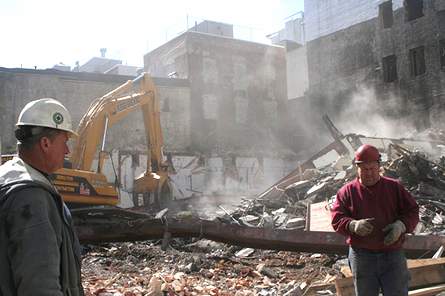
The push for cleaner diesel fuel is taking place nationwide. Federal law has been passed that will soon require trucks to use low sulfur diesel fuel, and place even tighter restrictions on newly manufactured trucks. Like the city and the state, Washington's law will phase in over time, giving trucking companies time to adjust their fleets.
There are, however, barriers to getting such protections in place immediately. It may be tough to make sure that the trucks are actually using the fuel, according to Charles Maikish, the Lower Manhattan Construction Command Center's executive director. Further, ultra-low sulfur diesel fuel may simply not be available yet in the quantities need. "I don't think we're going to see everyone switch all at once, because of a supply issue," said Maikish.
But increased demand is already beginning to change the diesel fuel market, say construction companies.
"When manufacturers and suppliers perceive a demand for products they'll create them," said Deane of Turner Construction.
DEMOLITION AT GROUND ZERO, AND FEAR OF FURTHER DAMAGE
Some workers and residents downtown do not see construction in and around Ground Zero as an opportunity to set a new environmental standard, however. Instead they worry about the potential to compound the environmental disaster of 9/11.
For the past five years, two buildings have sat within a block of Ground Zero, cloaked in black netting, filled with many of the same dangerous contaminants that sickened thousands of rescue workers and, critics say, unknown numbers of nearby residents and office workers.
Last week, the Environmental Protection Agency approved a plan to decontaminate and dismantle one, the Deutsche Bank Building just south of the site. A large crane is perched on the building, prepared to start what the head of the Lower Manhattan Construction Command Center describes as a yearlong "surgical deconstruction process". The approval process has been contentious, with critics questioning the quality – and criminality – of the firm contracted to clean the building, and the federal Occupational Safety and Health Administration recently expressing concern that the building might collapse.
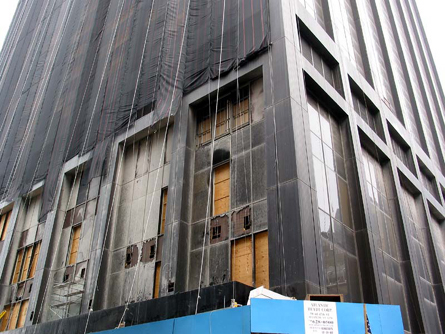
Local activists say the public review of the Deutsche Bank demolition plan has improved it, although they are still unhappy about the lack of a plan to mobilize the community in case of an accident in which contaminants are released. They are also concerned that the destruction of the other building – Fiterman Hall, just north of Ground Zero –will not be subject to similar scrutiny. Further, it is unclear how many other buildings may still be contaminated, or whether future demolitions could lead to the spread of such contaminants.
For Stein, the man working at 90 Church, this atmosphere has led to a feeling of distrust that leaves him wary of the nearby construction. He worries about the cumulative effect of construction pollution, since many projects will likely be built simultaneously over the next five to six years. Even if it is green, so much construction is bound to be dirty.
Â
Asthma, Poverty and Pollution
I don’t have asthma, but my sister Marta does, and so do at least 20 other people I know, most of whom take medication to control it. We all live in East Harlem, which has the highest rates of asthma in New York City – and the children in New York City were nearly twice as likely to have asthma in 2000 as kids in the United States as a whole, according to a report by the New York City Department of Health and Mental Hygiene.
Asthma is actually the most common chronic disease of childhood throughout the United States, and is the country’s number one cause of school absences each year. But kids in New York City have an especially difficult time with the condition, which causes a person’s airways or windpipes to narrow, resulting in difficult breathing, including wheezing, shortness of breath, chest tightness, and coughing. Over the last 20 years, the number of people in New York City diagnosed with asthma has increased and so has the severity of the illness, according to Dr. Beverley J. Sheares, associate clinical professor of pediatrics at Columbia University.
It is the kids living in low-income neighborhoods, like mine, that make the numbers so high. Hunts Point-Mott Haven and the High Bridge-Morrisania sections of the Bronx, East Harlem in Manhattan and Bedford Stuyvesant-Crown Heights in Brooklyn all have some of the most severe rates of asthma in the city. New York City children age 4 and younger who lived in low-income neighborhoods like these in the year 2000 were more than four times more likely to be hospitalized for asthma than those in wealthier areas. In my neighborhood, East Harlem, 435 children age 14 and younger were hospitalized for asthma in one year. (My sister Marta once stayed in the hospital for a whole week because of her asthma). Compare that to the wealthy Upper East Side, where only 40 children in that age range got hospitalized, less than one-tenth of the number in the neighborhood right next door.
Experts are a bit uncertain why asthma is so prevalent in low income areas, but many attribute it to pollution. “Communities like East Harlem are burdened with polluting facilities, like a multi-storied diesel bus depot operated by the New York City Transit Authority, a sanitation truck depot, and a sewage treatment plant on Ward’s Island,” said Yolande Cadore, organizing director of the environmental justice group West Harlem Environmental Action, Inc. ( WE ACT), in an email. “These communities bear the burden of high asthmas rates, lung and heart disease, obesity and diabetes.”
In the past five years, there has been some decrease in hospitalizations for asthma in New York. Dr. Sheares says this is at least partly due to groups that work in communities to keep asthma at bay. Harlem Children’s Zone Asthma Initiative is one of these groups. It has significantly reduced the need for emergency room visits for children with asthma involved in the program, and the program nearly eliminated their overnight hospital stays, the New York Times reported last year.
Harlem Children’s Zone focuses on working directly with children and their families. Its doctors and nurses visit the homes of children with asthma regularly, and lawyers help families deal with the housing problems common in low-income areas that are believed to contribute to asthma attacks, including mold, dust mites, and rodent infestation.
WE ACT takes a broader approach to alleviating asthma: They fight to keep pollution out of poor neighborhoods. Cadore says that city planners often build sewage treatment plants and bus depots in poor neighborhoods of color because they assume the community will not protest as much as a rich, white community might. Cadore said this is because historically minority communities have been less politically active, less likely to vote, and have had less money to sue.
Riverbank State Park, located in West Harlem between 137th and 145th Streets along the Hudson River, was built on top of the North River Wastewater Treatment Plant, which processes 170 million gallons of sewage each day. It handles the sewage of the entire western half of Manhattan and Riverdale in the northwest Bronx.
At one point, the plant was going to be built on 72nd Street. But developers saw the spot as a potential high-income area (it is where the Trump condos are now, so someone figured right), so the plant was built in Harlem.
The location was a bad choice for a sewage plant. Since it was up on a hill, the city had to spend additional money to install pumps to carry the sewage up from underground. When it opened in 1986, the putrid smell was overpowering. “The first summer it opened no one could open their windows or stand to breathe the air for extended periods of time,” said Cadore.
And the plant’s smoke stacks spewed diesel exhaust, which can trigger asthma attacks. Since West Harlem already suffered from high asthma rates, the plant was most likely harming those residents, said Cadore.
Peggy Shepard, who would eventually become the executive director of WE ACT, organized community residents to speak out. After they chained themselves across the street from the plant, the city installed proper odor and air pollution controls and built the park. Now locals can enjoy the park without the horrid smell that once came from the sewage plant.
As a means of fighting asthma, Cadore urges us to organize to protect our community against pollution. “It’s a right, not a privilege, to breathe clean air,” she said.
Additional reporting by Gamal Jones. Natalie Olivero, 17, and Gamal Jones, 20, are writers for New Youth Connections. Â
Noise In New York
Though it will not take effect until next July, the city’s new noise code seems to have few champions. Passed last December, the first revision to the code in 30 years was Mayor Michael Bloomberg’s effort to silence everything from dog barking to Mr. Softee trucks. But businesses, noise awareness groups and others find fault with the new law. They are especially doubtful it will be able to do much about the noise emitted by nightclubs, bars, and car alarms.
Meanwhile, both the noise in New York, and New Yorkers’ intolerance of it, seem to have increased. According to a poll of community leaders conducted by Baruch College's eTownPanel and released in July by the nonprofit Citizens for NYC, street noise is seen as the biggest infringement on the quality of life in New York City, rising from number three on last year's poll. And noise is the number one complaint phoned into the 311 hotline. In a recent month, there were 24,191 noise complaints, which was some 200 more than the same month two years earlier, which was around the time Bloomberg announced his anti-noise legislation.
By many measures, noise has become New Yorkers’ biggest concern.
What Can Government Do?
In late 2002, the mayor announced a citywide quality of life program in conjunction with the New York Police Department called Operation Silent Night, which targeted 24 zones throughout the five boroughs that were plagued by “chronic and disruptive” noise. As of August 2005, almost three years after its inception, the program made an example of nearly 20,000 noise violators with both misdemeanor and felony arrests.
Yet it would be difficult to find anybody who says that the problem is improving.
“You can’t rely on the government to solve a problem of respect,” said Peter Kostmayer of Citizens for NYC. “People need to understand that this is a problem they have more individual control over.”
Kostmayer believes noise pollution is a concern that needs to be tackled at the personal and community level. To stimulate that interest, Citizens for NYC will soon be awarding grants to neighborhood groups with innovative approaches that help solve the problem without legislation or police activity.
Glenn McAnanama, however, of the community organization Upper Green Side has a different interpretation of why the problem persists, despite the laws and initiatives in place.
“The people responsible for the noise production do not live in the areas where they produce the noise,” McAnanama said. “There is little social pressure that the community can apply to perpetrators, especially those in automobiles.
“For instance, every Saturday morning, when the garbage truck comes to pick up the trash, it creates a back-up all the way down the block and frustrated drivers express that by honking their horns.”
McAnanama believes that’s where governmental policy and enforcement can have a great impact. If traffic agents temporarily closed blocks of traffic while the truck made its pick-ups or had the pick-up dates coincide with the alternate parking side days, there would not be any anger-inducing gridlock.
Car Alarms
Despite their differences over the government’s role, both activists agree that car alarms are the most prevalent and intrusive of the noise pollutants.
In fact, one New York City-based group is working to ban car alarms all together, asserting that the audible anti-theft device is nothing but a neighborhood nuisance.
“The right way to stop alarm noise would be to ban noisy alarms, and the mayor hasn’t done this,” said Aaron Friedman, head of Silent Majority, referring to Bloomberg’s 2004 veto of council-approved legislation that would have banned the sale of certain kinds of audible car alarms. Bloomberg received flack at the time for holding on to the hope that car thieves are deterred by noisy alarms.
According to a 1997 analysis of insurance-claims data from 73 million vehicles, which was reprinted in a recent report by Transportation Alternatives, cars with alarms “show no overall reduction in theft losses,” when compared to cars without them or with silent alarms. The report, titled Alarmingly Useless, also figured the average New York City resident pays a car alarm “Noise Tax” of about $100 a year, based on lost productivity, decreased property value, diminished quality of life, and health costs.
Diseases exacerbated by noise include from cardiovascular disease, gastrointestinal illnesses, and psychological problems, according to well-established research that goes back to former U.S. Surgeon General Dr. Luther Terry, who is better-known for issuing the first warnings from the US Surgeon General about tobacco.
A German study conducted last year found that a person does not have to be annoyed by noise to be damaged by it -- cardiovascular disease was more closely related to the level of the sound than with the reaction to it.
Nightclub Noise
Currently, nightclubs can be cited if police officers simply determine “unreasonable noise.” But after discussions with the New York Nightlife Association, the City Council agreed to change the language of the new noise code and create a specific technical definition of “unreasonable noise.”
When the law takes effect next summer, officers will actually be using noise meters to measure sound levels 15 feet outside bars and clubs. If the establishment is 10 decibels or more above ambient sound in the daytime and seven decibels or more above ambient sound at night it will be issued a fine.
Despite the agreed-upon compromise, some owners feel they are being forced into a catch-22 situation by another quality of life measure, the smoking ban.
Bars and nightclubs face the loss of their operating license if state inspectors catch patrons lighting up inside, so they must force smokers onto the street. But this creates tension with neighborhood residents, who continually call the 311 hotline and complain about the late night noise from the smokers below their windows.
Robert Bookman, a lawyer for the New York Nightlife Association, said the law only addresses sound systems, not people. He described a scenario where a noisy outdoor restaurant can get by without a violation, but the bar next door is liable.
The New York Nightlife Association offered to pay off-duty police officers to patrol the streets and help keep the peace by preventing quality of life violations. So far the New York Police Department has refused the offer and the City Council has blocked a proposal supporting the effort.
Is Noise Necessary?
“Everyone is entitled to peace and quiet,” Peter Kostmayer said. “The question is whether it’s unnecessary. We live in a big city where a certain amount of noise is inevitable. But there are many more residential neighborhoods in Queens and Staten Island, where noise is not even an issue.”
Aaron Friedman of Silent Majority, however, said that notion reminds him of what someone living in New York a hundred years ago might have heard: “It’s like saying people need to realize that they are living in one of the biggest cities in the world, and that there are going to be a lot of tenement fires and cholera epidemics.”
And Glenn McAnanama of Upper Green Side said certain rights are being trampled when noise pollution is regarded as a necessary evil.
“People have a right to shape how the world around them is used,” he said. “If they want fewer cars coming into their area, they have a right to demand that people be encouraged and given the right incentives to take mass transit instead. If people want a dedicated lane that emergency vehicles can use to prevent blaring sirens, then they have a right to ask their public officials to do that.”
Several supplements to the noise code are already in the works. Councilmember Alan Gerson of lower Manhattan introduced five new bills, dealing with noise levels from circulation devices, portable generators, motorcycles with straight pipes, and construction work. He also plans to take up the issue of patio and courtyard restaurants.
The volume may be rising, but many believe that New York does not have to be the subject of so much auditory pollution. “It is completely within our control,” McAnanama said, “to reduce noise.”
Â




